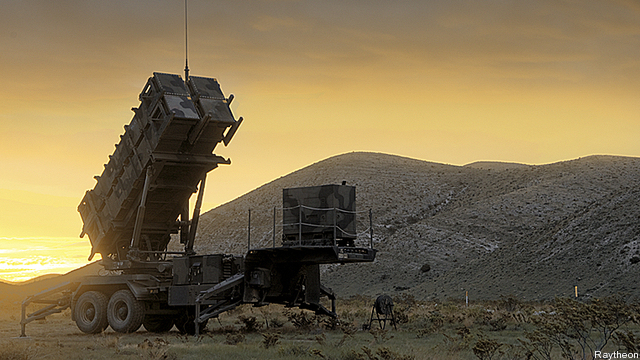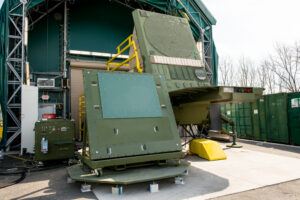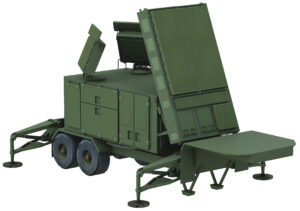The Biggest Thing Since Silicon: Raytheon’s Gallium Nitride Breakthrough
Posted on

Patriot missile launcher
WASHINGTON: It’s been a big week for arms exports. But sometimes the big story isn’t what you think. While headlines have focused on the US government’s decision to allow limited exports of armed drones, arguably the most important export policy change involved a material called gallium nitride (GaN).
“The gallium nitride story is an under-reported and really revolutionary development,” defense industry analyst and consultant Loren Thompson told me this morning. “People are saying it’s the biggest invention in semi-conductors since silicon.”

Loren Thompson
Yesterday, after a year-and-a-half-long process, the government granted Raytheon permission to export the latest upgrade of its Patriot missile defense system to 22 countries. (No one’s actually bought the upgrade yet, but the 12 current and 10 prospective Patriot customers on the list are now effectively pre-approved). The upgrade isn’t even to the Patriot missile itself, but to the radar.
The new technology improves reliability, range, and coverage. The only visible difference, though, is a pair of adorably ear-like extra panels at the back that give the radar a 360-degree field of view. But the “secret sauce” that makes the upgrade possible, Raytheon spokesman Michael Nachsen told me, is gallium nitride — and this is the first time the government has allowed the export of GaN in a land-based radar.
That doesn’t sound dramatic next to Tuesday’s State Department announcement that the US would permit exports of armed drones. Until now, only Britain has been allowed to buy them; even a proposed sale to Italy — a long-time NATO ally — aroused ire in Congress. The new policy has the potential to upgun allies and boost US industry before Chinese drones take all the market share, but at the price of proliferating a controversial weapon.
The thing is, Loren Thompson told me, “the policy on exporting armed drones is quite restrictive. It is only a loosening in the sense that previously there were no exports to anybody other than Britain. There are so many strings attached.”

The new (lower left) and old (upper right) Patriot radars.
Gallium nitride will “unquestionably” generate far more export dollars than armed drones, Thompson continued. “Gallium nitride is an embedded technology in potentially a vast array of systems,” he said, whereas armed drones are really one relatively narrow product category.”
Gallium nitride has such wide potential application — military and civilian — because it can carry higher voltage than older semiconductor materials. Higher voltage means higher efficiency, which in turn means the system uses less power and produces less heat. That’s why Raytheon can replace the Patriot radar’s single forward-facing panel with three active electronically scanned arrays (AESAs) without making the system bigger or requiring a new generator.

Upgraded Patriot radar, showing the two additional panels for rear coverage (at left)
The new components are also more reliable. “It doubles the reliability of the radar and cuts the O&M [operations and maintenance] cost in half,” Patriot upgrade program director Norm Cantin told me. (Of course, that’s an estimate from the manufacturer before anyone’s actually fielded the system yet). Upgrading an existing Patriot radar to the new gallium nitride won’t be free, Cantin said, “[but] if you build it from the ground up it’s actually less expensive.”
That makes it more attractive to Poland and Germany, which are both considering buying Patriot. The operations and maintenance costs, meanwhile, are the selling point for the cash-strapped US Army, which is currently conducting a formal analysis of alternatives (AOA) on whether to upgrade its existing Patriots to gallium nitride. The economics are such that once somebody buys, the cost goes down for everyone.
It took a while to get here. “Raytheon has spent a decade investing in gallium nitride,” said Loren Thompson. “They’ve even built a foundry in Andover, Mass. to build their own chips.” The company says it invested $150 million of its own money in the technology.
The hurdles weren’t just technological. “What we were asking for permission to export was pretty state of the art technology, and so getting export approval… took a little bit longer,” said Jack Cartland, Raytheon’s technical director for missile defense. “The low observable/counter low observable tri-service committee” — the relevant Pentagon body — “did not have policy on what would be permitted in terms of these high-technology AESA arrays.”
After Raytheon made its original request in late 2013, the committee needed until September 2014 just to thrash out a policy that would allow it to address the issue. It took from September until this week, almost six months, to get the specific answer to Raytheon’s specific request. That answer, of course, was “yes.” Now the question is whether the US Army and prospective foreign customers will say “yes,” too.
Subscribe to our newsletter
Promotions, new products and sales. Directly to your inbox.
